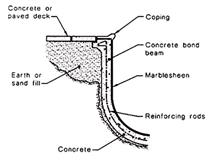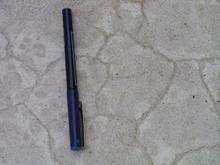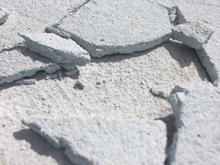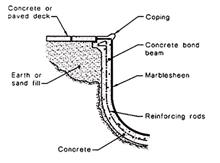- Home
- Know where asbestos is
- Marblesheen pool coatings containing asbestos
Asbestos
Marblesheen pool coatings containing asbestos
The below information provides guidance on asbestos safety for trades and contractors involved in maintenance, repair or renovation work of concrete pool shells.
It covers how to:
- identify swimming pools/spas with Marblesheen (Marblelite) finishes that may contain asbestos
- prevent exposure to asbestos fibres during maintenance, repair or renovation work.
What is Marblesheen/Marblelite?
Marblesheen, also known as Marblelite, is a decorative coating applied to the surface of concrete pool shells with average thicknesses between 5-25 mm. It is primarily composed of white cement and white marble chips between 1-2 mm in diameter (see Figures 1 and 2 below).
If the Marblesheen coating was applied prior to 1990, it may include asbestos.
Marblesheen pool coatings containing asbestos

An example of older Marblesheen coating

Identifying if a pool coating contains asbestos
The only way to confirm if a Marblesheen coating contains asbestos is to have a sample analysed by a National Association of Testing Authorities (NATA) accredited laboratory.
Prior to any maintenance, repair or renovation work occurring testing should be undertaken for:
- Marblesheen coated pools built before 1990 (all Marblesheen pools in this category should be assumed to contain asbestos)
- pools built before 1990 which have may been resurfaced (leaving the original Marblesheen coating in place underneath).
If testing has not occurred to pools built before 1990, it must be assumed they contain asbestos until they are tested.
If you are uncertain about what year the Marblesheen was installed, it is advisable to undertake testing prior to renovating or resurfacing.
Is there a risk of exposure to asbestos from Marblesheen coatings?
If the Marblesheen coating is in good condition and left undisturbed, it presents a low risk as it is non-friable and the asbestos fibres are bound to the cement.
However the effects of aging can result in deterioration of the surface, which in turn can create leaks. This deterioration may include:
- damage such as cracks, breaks and chips
- delamination of the coating from the concrete shell (creating drummy areas).
Deterioration may not be isolated to one area of the pool and depending on the circumstances, repairs may be extensive and require a complete resurfacing.
Complete resurfacing requires, at a minimum, removal of the old surface from around fittings and tiles to enable a flush finish for the new surface.
Complete removal of the Marblesheen is often necessary if the deterioration is extensive, or where any cracks or rust repairs to the pool shell require surface removal to complete the repair.
An example of deteriorated Marblesheen coating

Maintenance, renovation or demolition of asbestos-containing Marblesheen
Any work involving the removal or disturbance of Marblesheen coatings assumed or confirmed to contain asbestos must be done in accordance with the Work Health and Safety Regulation 2011 (WHS Regulation).
The table below outlines regulatory and licensing requirements for asbestos removal and asbestos-related work.
| Activity | Regulatory requirements |
|---|---|
| Minor repair work and/or removal of 10 m2 or less of asbestos containing material (ACM) | No asbestos removal licence required, however must undertake asbestos-related and/or asbestos removal work in accordance with the WHS Regulation 2011. |
| Removal of more than 10 m2 of ACM | Must be undertaken by a licensed asbestos removalist (class A or B licence) and all removal work must be in accordance with the WHS Regulation 2011. |
Further guidance on managing risks associated with asbestos and asbestos containing material can be found in the:
- How to manage and control asbestos in the workplace Code of Practice 2021 (PDF 1.1 MB)
- How to safely remove asbestos Code of Practice 2021 (PDF 2.2 MB)
Removal or repair of Marblesheen coating generally requires the use of power tools to break away the Marblesheen. The use of power tools will generate airborne asbestos fibres and other dusts including silica. Queensland laws prohibit the use of certain tools and work methods when working with ACM.
When working with or removing asbestos-containing materials:
- Never use high-pressure water spray or compressed air on asbestos or ACM.
-
Never use any of the following on asbestos or ACM unless their use is controlled*:
- power tools (including grinders, sanders and jackhammers)
- brooms
- any other implements that cause the release of airborne asbestos into the atmosphere.
*The use of equipment is controlled if one or more of the following applies:
- the equipment is enclosed during its use
- the equipment is designed to capture or suppress airborne asbestos and is used in accordance with its design
- the equipment is used in a way that is designed to capture or suppress airborne asbestos safely
- any combination of the above.
Transport and disposal of asbestos-containing Marblesheen
All debris must be double bagged or double wrapped in 200 µm plastic and disposed of at an approved waste disposal facility. Weight limits may apply for transporting asbestos waste.
Find out more about transport and disposal of asbestos waste.

- Home
- General information
- What is asbestos?
- How was asbestos used?
- Are there health effects?
- The risks of exposure
- Health monitoring
- Legislation and codes of practice
- Low density asbestos fibre board
- Asbestos contaminated dust or debris
- Fires
- Cleaning up after floods and storms
- Importation prohibited
- Government and agency roles
- Asbestos in government assets
- Know where asbestos is
- Removing or disturbing asbestos
- Practical guidance
- Resources
- Asbestos alerts
- Asbestos news
- Codes of practice
- Guidance
- Films
- Asbestos safety session 2021
- Asbestos safety session 2020
- Cleaning Asbestos Roofs
- Shadow vacuuming with a H-Class vacuum cleaner
- Use and maintenance of a H-Class vacuum cleaner
- Identifying low density asbestos fibre board hazards and risks
- Working safely with asbestos for the home renovator
- How to properly wear personal protective equipment for airborne contaminants
- Personal protective equipment
- Dear Dad - An asbestos awareness film
- Clear and present danger: Asbestos exposed
- Uses and applications of asbestos - an extract from a film by Parsons Brinckerhoff
- Asbestos health issues - an extract from a film by Parsons Brinckerhoff
- Safe work procedure - storm and wind damage cleanup
- Drilling into asbestos walls and ceilings
- Asbestos - Removing switchboard panels
- Decontamination procedure, personal decontamination and cleanup procedures
- Asbestos awareness
- Safe work procedures
- Preparation before commencing the task
- Preparing and painting corrugated asbestos cement roof and fences
- Drilling into non-friable asbestos using a thickened substance to control airborne fibres and dust
- Drilling into non-friable ACM using an H rated industrial HEPA filter vacuum to control airborne fibres and dust
- Removing a small package electrical switchboard
- Cleanup and disposal
- Safe cleanup of storm damaged materials that may contain asbestos
- Frequently asked questions for homeowners and the general public
- Podcasts
- Strategies
- Working Safely with Asbestos Guide
- Asbestos awareness week 2025
- Asbestos management compliance campaign
- Induction and safety training for unlicensed work
- Sanctions